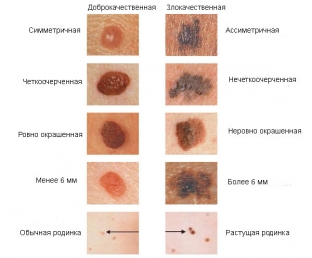Moles are present on the body of every person, the bulk of which (90%) appears by the age of 25. However, they can also appear later under the influence of various events, for example, the peak of the appearance of moles often falls during pregnancy. As for color, nevi are very diverse – black, brown, yellow.
At first glance, the moles on the body do not differ from each other. However, there are signs by which a malignant skin lesion can be distinguished from a benign one.
How to identify a malignant mole on the body
Doctors recommend regularly examining your own body for suspicious moles or neoplasms.
In order to facilitate the process of identifying atypical nevi, specialists have developed a special method called ABCDE, where each letter indicates a suspicious sign that is worth paying attention to.
A (asymmetry) – asymmetry. It is worth sounding the alarm if the mole begins to grow unevenly to the sides. The norm is such a form of a mole when, when drawing an imaginary line, its halves will be symmetrical.
B (border irregularity) – Jagged edge. Ragged and fuzzy edge – one of the signs of melanoma. The edges of benign skin lesions are usually smooth.
C (color) – color. A visit to the doctor is mandatory if there are areas of different tones on the mole, and also if its color and shades change. For example, a mole that changes color according to the "black & ndash; blue & ndash; brown" scheme is most likely malignant.
D (diameter) – diameter. If the diameter of the mole exceeds 6 mm, it is worth visiting a doctor.
E (evolving) – variability. If you notice that within a week there was a sharp increase in the mole, and then it decreased again – try to postpone all affairs and visit a doctor. Experts recommend not to postpone the medical examination in this case, as if treatment is required, it should be started as soon as possible.

Checking the body for suspicious moles – a mandatory procedure for everyone without exception, however, this process of a certain category of people should be taken three times more seriously. Persons whose relatives suffered from melanoma or other oncological diseases are especially susceptible to the risk of malignant tumors. Also, the owners of blond hair and fair skin should be especially careful.
If the doctor detects alarming symptoms, they will be assigned a dermatoscopy and possibly an individual photomap of moles will be created.
Source estet-portal.com






Add a comment